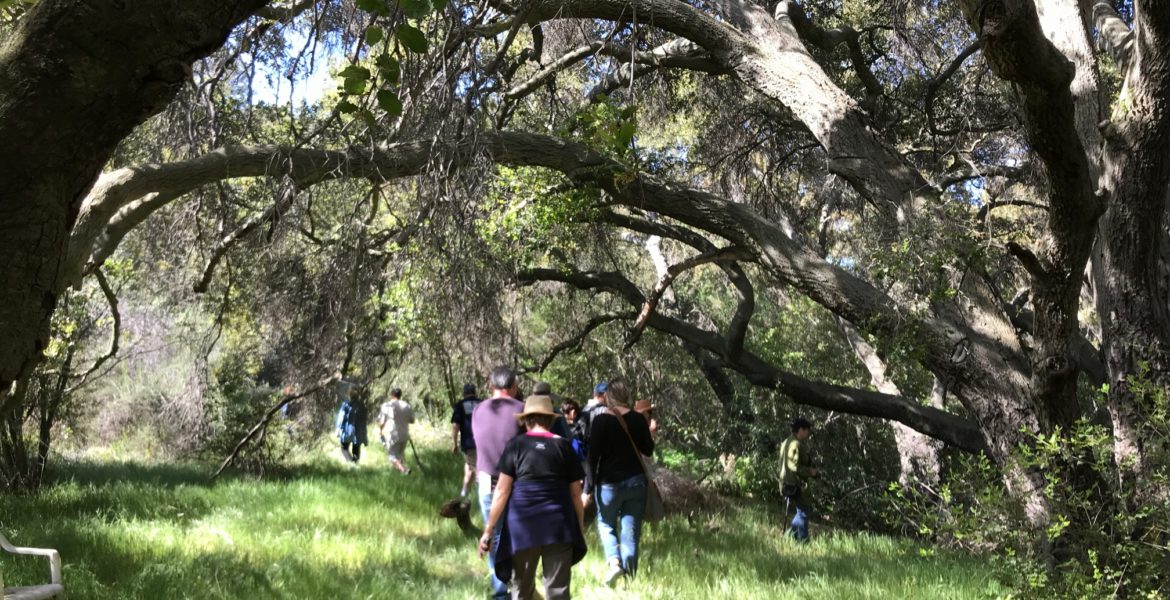When Don Wallace, “The Trail Guy,” invites you on a walking tour, you readjust your schedule and block out what will be a couple of hours never to be replicated again in your lifetime.
So it was that a small group of like-minded conservationists lined up behind Wallace in his ATV, to follow along Cold Creek, one of the few perennial streams in the area, through a rarely visited pristine section of Cold Canyon.
Wallace, a retired firefighter and longtime trails advocate, who moved to the area in 1972, interspersed the hike with stops at historical high points that made the experience more than just a nature walk.
Disembarking from the cart, he led the party up a rocky trail to a small cave, which, he explained, the Ventureno Chumash Indians used as shelter and a 360-degree lookout to the mountains beyond and a valley meadow below sprinkled with tiny lupine. Later, larger versions of lupine, such as we see along roadsides this time of year, appeared and, further on, the showy bush lupine.
From the meadow, we trod along an oak woodland trail, avoiding poison oak vines that threatened bare ankles or cheeks that unwittingly brushed by. Pushing through undergrowth, Wallace cleared a path to the bedrock mortar, a large stone, now covered in moss and lichen, and its two grinding holes, once used by the Indians who camped there, now filled with debris from towering oak trees.
Under the Homesteading Act of 1862, the Baynes family homesteaded 160 acres in the Cold Creek watershed. They dammed the creek for easy water access and built a bridge. The Baynes married into the Murphy family and their descendants donated the property to the MRT that became the Murphy Preserve, then the Cold Creek Preserve. The property burned in the Wright fire of 1970 and when the MRT took it over, they removed the house foundation and the dam, and replaced the original bridge.
The bridge led us upstream to the last of our historic stops, the Heritage Grapevine. As we meandered through dry open spaces inhabited by prickly chia flowers, goldfield, and yucca, downward to the stream, one of our party hoped aloud that we would find a rare stream orchid.
The stream ran close by and clear and in a moment, an exclamation echoed through the canyon, “Here it is!”
Indeed, growing in the stream was a grove of green, two-foot high plants with lance-shaped leaves under which hid the tiny inch-long orchid, with petals of greenish-yellow, pink, coppery red veins and contrasting gold along the lower lip.
“I can cross that one off my bucket list now,” she said, as we moved on to the grapevine just steps away.
Wallace pointed to the historic grapevine, its spindly vines just sprouting spring-green leaves. The vine was certified by the UC Davis DNA lab as a cutting from the first grapevines imported from Spain to the San Gabriel Mission circa 1567 and were probably planted by the Baynes family around 1900.
According to the MRT website, Cold Creek Preserve today consists of about 1600 acres that protect one of southern California’s most pristine free-flowing, perennial creeks and its surrounding ecosystems.
On April 13, city, county and state officials honored Wallace when they dedicated the 1,700-foot Don Wallace Multi-Use Trail Connector, a trailhead that connects the Pacific Crest Trail south to Mexico and north to Canada.
About Cold Creek—In 1984 the Nature Conservancy deeded 525 acres of the watershed to MRT, which formed the initial portion of Cold Creek Preserve. Since then, MRT has worked in partnership with multiple agencies and property owners to acquire key parcels to connect critical segments, such as the east-to-west wildlife corridor that links Topanga State Park and Malibu Creek State Park. Together, MRT, California State Parks, National Park Service, Los Angeles County, Santa Monica Mountains Conservancy and the UC Reserve System manage the Cold Creek basin to protect its pristine ecosystem. The watershed’s boundaries extend above Mulholland Highway, while the area drained by Cold Creek is about 4.5 miles from a high point at Saddle Peak. Cold Creek is designated as a Significant Ecological Area (SEA) within the Santa Monica Mountains.

